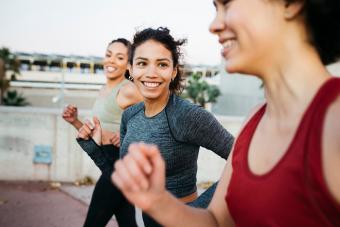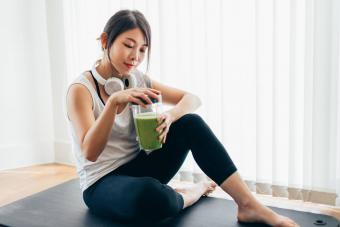
The amount of oxygen and other gases circulating through your blood during exercise indicates how effectively you take in and process oxygen. The number can provide you with a means to measure your physical capabilities, particularly when it comes to endurance events like long-distance running.
What Is Oxygen Saturation?
The clinical term for blood oxygen levels is oxygen saturation. It provides a basis for you to understand the numbers that are used to describe how much oxygen is in your blood.
When your blood oxygen levels are measured, you get a result in a percentage, which represents the number of red blood cells in your blood that are filled with oxygen. When your blood doesn't have enough oxygen, it's known as hypoxia.
These percentages report both arterial (oxygen-rich blood headed toward your muscles) and venous (oxygen-depleted blood rushing back toward your heart) numbers in the most thoroughly controlled situations.
Oxygen Saturations Levels
Exercise physiologists provide numbers that you can use to interpret your oxygen saturation levels.
- 95 to 100 percent are normal
- 91 to 94 percent indicate mild hypoxia (loss of oxygen)
- 86 to 90 percent indicate moderate hypoxia
- Anything under 85 percent indicates severe hypoxia requiring immediate medical attention.
If you notice consistent levels from 86 to 90 percent, you may need to see a doctor, or your meter may not be measuring accurately. Test it on a few other subjects to see if the meter measures their oxygen levels as low and to determine whether you need to seek medical attention or you're just experiencing technical difficulties.
The Effect of Exercise
When arterial numbers are normal, usually about 95 to 100 percent, you're breathing in and using plenty of oxygen. These numbers generally stay unchanged during moderate-intensity exercise and may even increase a little with the intensity, suggesting you're breathing faster and therefore taking in more oxygen.
With more vigorous exercise, you may note a small drop in blood oxygen levels of about 2 to 3 percent if your respiration doesn't continue to bring in enough oxygen to meet your body's current needs. In this case, you may notice levels as low as 92 percent.
However, these levels will return to your normal reading when you stop exercising. The better shape you are in, the more quickly you will see these levels return to the normal range.
Interestingly, venous measurements are always quite a bit lower than their arterial counterparts due to the fact that venous blood has already had the oxygen extracted. Logically, your venous blood oxygen levels gradually decrease as the intensity of your workout increases, showing that your body is using the oxygen you're taking in.
Impact on Fitness and Health
Oxygen is required for fast, efficient energy production. When you use oxygen to create energy, it is called aerobic metabolism. Aerobic means "with oxygen." Your body can still burn fuel without oxygen, but anaerobic energy production (without oxygen) is slow and inefficient.
If your arterial oxygen levels remain high during exercise, this is a good indication your body is well-adapted and can continue to bring in and process enough of the gas, even when you're working at high intensities. Low blood oxygen levels could also signal certain health conditions and a lower level of fitness.
How to Measure Blood Oxygen Levels
There are multiple approaches to measuring blood oxygen levels.
Clinical Lab Method
In laboratory settings, researchers may place a catheter in specific arteries and veins to directly measure the amount of oxygen contained in the blood. This procedure is highly invasive and can only be done by trained professionals with specialized equipment. For most people, the clinical method is not feasible
Pulse Oximeter
The most commonly used method of measuring blood oxygen levels in hospitals is a small device that resembles a clip. The device is called a pulse oximeter and is placed on a small, translucent part of your body like a fingertip or ear lobe. By shining a light through your skin to a sensor on the other side, the device very cleverly uses the color of your arterial blood to estimate the amount of oxygen contained within.
Consumers can buy a pulse oximeter for home use. They can range anywhere from about $15 to $400 for a professional-grade device.
Trackers and Apps
Fitness trackers and smartphone apps can measure blood oxygen with varying degrees of reliability. When a fitness tracker is worn on the wrist, bones, muscle, connective tissue, and veins in the wrist can distort the reading the device produces.

Some smartphone apps also advertise that they can measure blood oxygen levels. The level is usually predicted by having the user place a fingertip over the flash and camera lens.
For most people, either smartphone apps or wearables will be the tool of choice for measuring blood oxygen levels while exercising. But since the technology is new it hasn't been well studied.
Personal Signs and Symptoms
You don't need a device to estimate your blood oxygen levels. There are symptoms to look for if you're concerned that your levels might be too low.
Primarily, you will feel light-headed, dizzy, and short of breath. You may even experience a loss or dimming of vision. If you feel any of these symptoms, stop exercising immediately.
If you continue to feel that way for an extended period after your workout has ended, or if the symptoms arise even without a workout, see your doctor as soon as possible.
Should You Measure Your Oxygen Levels?
Unless your doctor recommends measuring your blood oxygen saturation, there is no reason to track your levels regularly. However, you may choose to measure it out of sheer curiosity. For those casual purposes, a wearable tracker or cell phone app should be able to give you all the information you need.
If you track your levels to follow your progress with a fitness program or for other casual purposes, try to use the same device each time you measure. Different devices can provide slightly different numbers. And keep in mind that there are many different indicators of good health and wellness. If you don't get the number you want, reach out to a trained fitness professional to get a complete fitness assessment.







